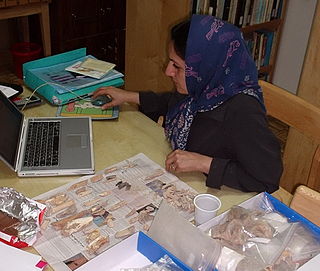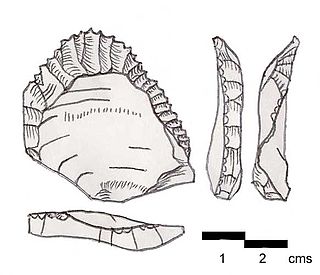
Shanidar Cave is an archaeological site located on Bradost Mountain, within the Zagros Mountains, in the Erbil Governorate of Kurdistan Region in northern Iraq. It is known for the discovery of Neanderthal remains at the site, most notably Shanidar 1, who survived several injuries during his life, possibly due to care from others in his group, and Shanidar 4, the famed 'flower burial'. Until this discovery, Cro-Magnons, the earliest known H. sapiens in Europe, were the only individuals known for purposeful, ritualistic burials.
The Middle Paleolithic is the second subdivision of the Paleolithic or Old Stone Age as it is understood in Europe, Africa and Asia. The term Middle Stone Age is used as an equivalent or a synonym for the Middle Paleolithic in African archeology. The Middle Paleolithic broadly spanned from 300,000 to 30,000 years ago. There are considerable dating differences between regions. The Middle Paleolithic was succeeded by the Upper Paleolithic subdivision which first began between 50,000 and 40,000 years ago. Pettit and White date the Early Middle Paleolithic in Great Britain to about 325,000 to 180,000 years ago, and the Late Middle Paleolithic as about 60,000 to 35,000 years ago.

The Levallois technique is a name given by archaeologists to a distinctive type of stone knapping developed around 250,000 to 300,000 years ago during the Middle Palaeolithic period. It is part of the Mousterian stone tool industry, and was used by the Neanderthals in Europe and by modern humans in other regions such as the Levant.

The Do-Ashkaft Cave, being a Middle Paleolithic cave site, is located north of Kermanshah, near Taq-e Bostan, Iran about 1,600 m (5,200 ft) above sea level. Its entrance faces south of Meywala Mount, overlooking the national park of Kuhestan. The site was first visited in 1996 by Iranian researchers F. Biglari and S. Heydari-Guran and during the following four years a series of surface surveys were made at one-month intervals, which resulted in a rich collection of Middle Paleolithic lithic artifacts.
Harold Lewis Dibble was an American Paleolithic archaeologist. His main research concerned the lithic reduction, during which he conducted fieldwork in France, Egypt, and Morocco. He was a professor of Anthropology at the University of Pennsylvania and Curator-in-Charge of the European Section of the University of Pennsylvania Museum of Archaeology and Anthropology.

Fereidoun Biglari is an Iranian archaeologist and a museum curator.

Marjan Mashkour is an archaeologist and member of the French National Centre for Scientific Research. She is the first Iranian to specialize in the field of zooarchaeology and has been engaged in many field and laboratory projects in Iran and the Near East.

Ksar Akil is an archeological site 10 km (6.2 mi) northeast of Beirut in Lebanon. It is located about 800 m (2,600 ft) west of Antelias spring on the north bank of the northern tributary of the Wadi Antelias. It is a large rock shelter below a steep limestone cliff.

The Wezmeh Cave is an archaeological site near Islamabad Gharb, western Iran, around 470 km (290 mi) southwest of the capital Tehran. The site was discovered in 1999 and excavated in 2001 by a team of Iranian archaeologists under the leadership of Dr. Kamyar Abdi. Wezmeh cave was re-excavated by a team under direction of Fereidoun Biglari in 2019.

The Skhul/Qafzeh hominins or Qafzeh–Skhul early modern humans are hominin fossils discovered in Es-Skhul and Qafzeh caves in Israel. They are today classified as Homo sapiens, among the earliest of their species in Eurasia. Skhul Cave is on the slopes of Mount Carmel; Qafzeh Cave is a rockshelter near Nazareth in Lower Galilee.

The prehistory of the Iranian plateau, and the wider region now known as Greater Iran, as part of the prehistory of the Near East is conventionally divided into the Paleolithic, Epipaleolithic, Neolithic, Chalcolithic, Bronze Age and Iron Age periods, spanning the time from the first settlement by archaic humans about a million years ago until the beginning of the historical record during the Neo-Assyrian Empire, in the 8th century BC.

Southwest Asian Neanderthals were Neanderthals who lived in Turkey, Lebanon, Syria, Palestine, Israel, Iraq, and Iran - the southernmost expanse of the known Neanderthal range. Although their arrival in Asia is not well-dated, early Neanderthals occupied the region apparently until about 100,000 years ago. At this time, Homo sapiens immigrants seem to have replaced them in one of the first anatomically-modern expansions out of Africa. In their turn, starting around 80,000 years ago, Neanderthals seem to have returned and replaced Homo sapiens in Southwest Asia. They inhabited the region until about 55,000 years ago.

Krapina Neanderthal site, also known as Hušnjakovo Hill is a Paleolithic archaeological site located near Krapina, Croatia.

Pešturina is a cave in the municipality of Niška Banja in southeast Serbia. It is southwest of Jelašnica and 20 km (12 mi) southeast of Niš. Artifacts from the Middle and Upper Paleolithic periods were discovered since the archaeological excavations began in 2006. The remains, identified as the Mousterian culture, were dated from 111,000 BP+ 5,000 to 39,000 BP + 3,000, which makes Pešturina one of the latest surviving Neanderthal habitats. The cave has been nicknamed the "Serbian Atapuerca".
Qafzeh Cave, also known by other names, is a prehistoric archaeological site located at the bottom of Mount Precipice in the Jezreel Valley of Lower Galilee south of Nazareth. Important remains of prehistoric people were discovered on the site - some of the oldest examples in the world, outside of Africa, of virtually anatomically modern human beings. These were discovered on the ledge just outside the cave, where 18 layers from the Middle Paleolithic era were identified. The interior of the cave contains layers ranging from the Neolithic era to the Bronze Age.
Amud Cave is located in the Upper Galilee, in the Nahal Amud gorge. It is situated about 30 m (98 ft) above Nahal Amud, right next to and above the famous pillar for which Nahal Amud is named. The cave was excavated by a Japanese expedition in 1961 and, again, in 1964. Excavations were renewed in 1990 by a joint Israeli-American team that included archaeologists, anatomists and anthropologists. Two major phases of occupation have been identified on the site: the later one beginning at around 3000 BC, characterized by numerous pottery sherds, stone tools and garbage pits but no permanent structures, and an earlier one from the Middle Paleolithic. The most important find from this site is Amud 1, discovered in 1961, in the latest Paleolithic layers, that were later dated, using thermoluminescence, to 50-60,000 years BP. It has been classified as Neanderthal, which makes it the youngest Neanderthal ever to have been discovered in the Levant.
Wezmeh Child or Wezmeh 1 represented by an isolated unerupted human maxillary right premolar tooth of an individual between 6–10 years old. It was found with large numbers of animal fossil remains in a cave site called Wezmeh near Islamabad Gharb, western Iran, around 470 km (290 mi) southwest of the capital Tehran. The site was discovered in 1999. The premolar is relatively large compared with both Holocene and Late Pleistocene P3 and P4. Researchers analyzed it by non-destructive gamma spectrometry that resulted in a date of around 25,000 years BP. But later analysis showed that the gamma spectrometry dates the date was minimum age and the tooth is substantially older. Endostructural features and quantified crown tissue proportions and semilandmark-based geometric morphometric analyses of the enamel-dentine junction aligns it closely with Neanderthals and shows that it is distinct from the fossil and extant modern human pattern. Therefore, it is the first direct evidence of Neanderthal presence in the Iranian Zagros. Given that the cave was a carnivore den during late Pleistocene, it is probable that the Wezmeh Child was killed, or had its remains scavenged, by carnivores who used the cave as den. Within an approximate 30 km radius of the Cave, 13 Middle Paleolithic sites have been recorded; among them, the nearest sites are located about 10 km to the northwest. The tooth is on display at Paleolithic gallery of National Museum of Iran













